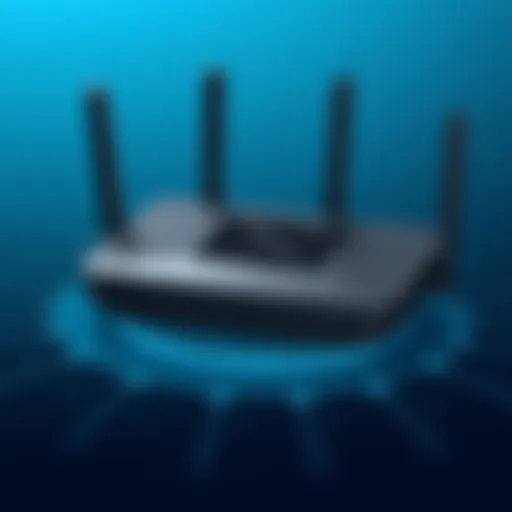Understanding 110V to 12V DC Converters for All Users
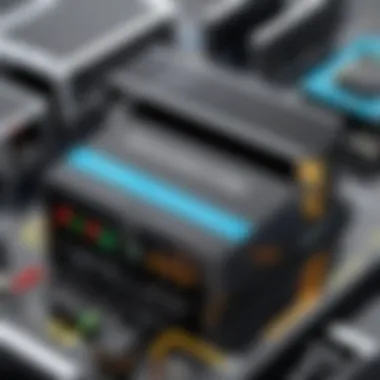

Intro
The shift from standard household voltage to a lower DC voltage is more than a mere electrical transition; it represents a fundamental change in how we interact with modern electronics. Devices that run on 12V direct current (DC) are commonplace, from LED lights to automotive systems, yet their operation hinges on reliable voltage conversion. Understanding how 110V to 12V DC converters work becomes essential, especially for tech enthusiasts, gamers, and DIY builders. This guide provides not just a peek into these devices but also equips readers with the knowledge needed to select, install, and maintain them effectively.
In this comprehensive exploration, we will delve into various aspects of converters, including their mysteries and marvels, the technical specification breakdown, and a comparative analysis of competing products. Our aim is to empower you with practical insights that could transform your electronic projects or repairs. Let’s dig deeper into the world of voltage converters, starting with a broad overview of the product itself.
Understanding Voltage Conversion
Understanding voltage conversion is crucial to grasping the principles behind the effective functioning of electronic equipment. Whether you’re building a custom circuit or tweaking existing devices, knowing how voltage works not only informs your design but also helps you sidestep many common pitfalls. Essentially, voltage conversion entails changing an input voltage level to a different output voltage level, often achieving this through devices known as converters.
The Concept of Voltage
Voltage, often dubbed electrical potential difference, is essentially the force that moves electric charges through a conductor. To put it plainly, think of it like water pressure in a hose. The higher the pressure, the more water can flow out. In electronics, voltage measures the potential energy available to push electrons through a circuit. Understanding this concept creates a firm foundation for wrestling with the more complex ideas that lie ahead in this journey of voltage conversion.
Some key points to consider about voltage include:
- Units of Measurement: Voltage is measured in volts (V).
- Foundation for Electrical Circuits: Without voltage, there'd be no current—no flowing electrons to power your devices.
- Behavior in Circuits: The distribution of voltage in circuits can affect overall performance and efficiency, crucially impacting any device's functionality.
Alternating Current vs. Direct Current
When we talk about voltage, we often find ourselves facing two main types of electrical current: alternating current (AC) and direct current (DC).
- Alternating Current (AC) is a type of current where the flow of electricity periodically reverses direction. In most household voltages, like the standard 110V, this is commonly seen. AC is the go-to current type for most appliances in your home.
- Direct Current (DC), on the other hand, moves in a single direction. This is the type of current found in most batteries and many electronics, where a uniform flow is needed.
Understanding the difference is vital when dealing with converters, as a device designed for one type may not work properly with the other. For example, converting from AC to DC requires specific methods due to their inherent differences in behavior.
Importance of Voltage Regulation
When setting up your devices, it’s not just important to transform voltage; it’s also crucial to regulate it. Volatile voltage can lead to devices malfuctioning, or even getting damaged. Picture a car running on uneven fuel supply: the engine struggles, and so does performance.
- Stability: Voltage regulation ensures that the devices experience consistent voltage levels, thereby enhancing performance and reliability.
- Protection: Voltage regulators thwart excess input voltage which can fry your components.
- Efficiency: Good voltage regulation can lead to less wasted energy, translating into lower power bills and a greener footprint.
In summary, understanding voltage conversion is more than just knowing how to switch one voltage to another; it's about gaining insights into the mechanisms that keep your electronic world humming. The relationship between voltage types and regulation highlights why knowledge in this area is critical for anyone looking to optimize electronic setups.
An Overview of 110V to 12V Converters
When discussing the world of electronics, the transition from 110V to 12V DC converters serves as a vital focal point. These devices are not just any ol' tools; they're bridges that connect our common household electrical supply to a range of applications that demand lower voltage levels. Understanding their operation and capabilities is crucial for anyone looking to enhance or repair electronic systems.
This overview emphasizes why knowing about these converters is essential. They come into play in various contexts, from powering home electronics to DIY automotive projects. Many modern devices operate efficiently at 12V DC, making these converters a linchpin in the technical toolkit. As energy demands continue to rise, the significance of voltage conversion cannot be overstated; it aligns with both practical applications and emerging technologies.
What is a Converter?
A DC converter is a device that transforms direct current (DC) voltage levels from one voltage to another. In simpler words, it's like a middleman, adjusting the voltage to suit the needs of specific equipment. There are two main categories of converters: step-up and step-down. 110V to 12V converters specifically fall into the step-down category, taking your standard household voltage and converting it into a lower voltage that is often required for devices.
For instance, if you have a 12V light that you want to run using a standard 110V outlet, this converter is the key to making it happen. From simple circuits to advanced systems, these converters make sure that devices are provided the power they require without any hiccups linked to overheating or overvoltage that could potentially damage sensitive electronics.
Functions of 110V to 12V converters
The functions of these converters are broad and varied, and understanding them can make you a more savvy user. Here are some critical functions they serve:
- Power Supply Control: By stepping down the voltage, these converters ensure that the devices receive the appropriate amount of power without risking overload.
- Energy Efficiency: Many converters are designed with efficiency in mind, allowing them to operate without wasting energy, which is particularly important in battery-powered applications.
- Safe Operation: Beyond just voltage transformation, converters come with various protective features—like short circuit protection and thermal overload protection. These features allow users to rest easy knowing their devices are safeguarded.
- Versatile Applications: From automotive headlights to LED strips in home decor, they’re used widely across different sectors. They’re a popular choice for hobbyists and professionals alike, including those who dabble in DIY projects.
As you delve into the specifics of these converters, it's essential to keep in mind not just their functions, but also the reliability that comes with well-chosen devices. This knowledge arms users with insights necessary for selecting converters that best match their intended application.
Types of 110V to 12V Converters
Understanding the different types of converters available for stepping down 110V AC to 12V DC is crucial for anyone looking to utilize such devices effectively. Each type comes with its own benefits and considerations, tailored for specific applications and requirements. Whether you're a tech enthusiast or a professional in need of efficient conversion solutions, grasping these differences can enhance your project outcomes.
Linear Voltage Regulators
Linear voltage regulators are the simplest form of DC converters. They work by dissipating excess voltage as heat, offering a steady output voltage that’s less impacted by input voltage variations.
- Benefits of Linear Regulators:
- Simplicity in design and ease of use.
- Low noise output, making them ideal for sensitive electronics.
- Cost-effective for smaller power requirements.
However, they aren’t without their downsides. Linear regulators tend to be inefficient when dropping substantial voltage since the excess is converted to heat. For instance, if a regulator needs to drop 110V to 12V, quite a bit of energy gets wasted as heat, which might lead to overheating issues in the absence of proper heat management systems.
"In applications where noise is crucial, like in audio equipment, linear voltage regulators shine as they produce minimal fluctuations in the output."
Switching DC-DC Converters
Switching converters, on the other hand, employ a different approach. They use a series of switches, transistors, and inductors to regulate voltage more efficiently, allowing for much higher conversion efficiencies — often exceeding 90%.
- Advantages of Switching DC-DC Converters:
- Great efficiency, minimizing power loss.
- Ideal for applications needing a higher output current.
- Smaller size compared to linear regulators due to less heat generation.
These converters handle variations in load without the same level of inefficiency that linear regulators exhibit. However, their complexity can be a barrier for those who prefer simplicity in setup and operation. For instance, using a switching converter may entail additional components and careful attention to signal integrity, especially in sensitive or low-noise environments.
Buck and Boost Converters
Buck and boost converters are specialized versions of switching converters. Buck converters step down the voltage—meaning they take a higher voltage input and convert it to a lower output. Boost converters, in contrast, elevate the voltage. Their ability to function effectively in both scenarios makes them invaluable in a number of applications.
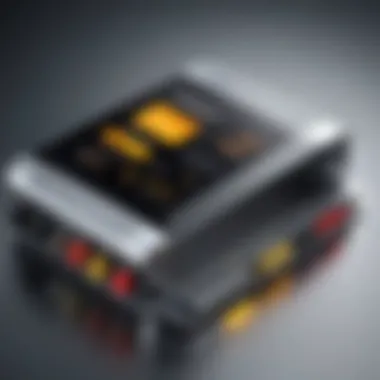

- Benefits of Buck Converters:
- Advantages of Boost Converters:
- Increased efficiency over linear types, especially in high-current applications.
- Versatile, can work in a variety of settings, such as battery chargers.
- Useful for powering devices that require a higher voltage than the supply source can provide.
- Stable output voltage across different input levels.
Each type’s choice could impact your project drastically, affecting everything from performance to energy costs. A well-laid-out plan can ensure that the right converter type is selected based on specific needs and results in an efficient and reliable power supply for your devices.
Technical Specifications
Understanding the technical specifications of 110V to 12V DC converters is vital for anyone looking to power devices efficiently. These specifications dictate how effectively a converter will function in various circumstances. They not only inform potential users about the performance capabilities of a converter but also help in identifying the right unit for specific applications. Technical specifications include several key features that ultimately affect installation, performance, and reliability.
Output Current Rating
The output current rating is one of the most critical technical specifications when selecting a DC converter. It indicates the maximum current the converter can supply to load devices. Knowing this rating is essential as it prevents damage that can occur from overloading. If a converter isn’t rated for the current needed by a device, it might not work at all or fail catastrophically.
In practical terms, if you're using a converter for a car stereo or an LED lighting system, understanding the output current helps you identify whether the converter can handle all connected devices. For example:
- Low-demand Devices: A simple LED strip might only require 1A.
- High-demand Devices: On the other hand, a heavier-duty application such as a portable subwoofer could demand 5A or more.
Choosing the right output current rating ensures stability and protects your investment.
Efficiency Ratings
Efficiency ratings express how well a converter transforms input power to output power. This is usually depicted as a percentage. A higher efficiency rating means that less energy is wasted during conversion, which can result in lower electricity costs and less heat generation.
For instance, a converter with an efficiency rating of 90% ensures that 90% of the input power is converted into usable output. The 10% that is lost largely turns to heat, which can have implications for thermal management. It’s crucial to consider:
- Operational Costs: Greater efficiency means reduced electricity costs over time.
- Heat Generation: Less heat means better reliability and longevity of the converter.
Thermal Management
Thermal management refers to the strategies used to control the temperature of a device during operation. Given that DC converters can generate significant heat under load, effective thermal management can dramatically enhance the performance and lifespan of the converter.
Heat can be generated for multiple reasons:
- High Current Demand: Exceeding the output current rating can cause overheating.
- Inefficient Designs: Poor design or low-efficiency ratings lead to excessive heat.
To mitigate thermal issues, consider the following:
- Heat Sinks: Utilizing heat sinks can dissipate heat away from crucial components.
- Adequate Ventilation: Ensuring sufficient airflow around the converter can prevent heat build-up.
- Thermal Cutoffs: Some advanced models even integrate built-in thermal cutoffs that disconnect power if overheating occurs.
By paying close attention to thermal management, you can ensure smoother operations and extend the overall life cycle of your converter.
"Always respect the heat—it's a tricky dance between efficiency and performance."
Understanding these technical specifications not only assists in making informed decisions but also ensures that your endeavors with 110V to 12V DC converters are both fruitful and sustainable.
Applications of 110V to 12V Converters
When we talk about 110V to 12V DC converters, it’s like diving into a treasure chest filled with possibilities. These little devices play a crucial role in multiple realms of electronic circuitry and electrical systems. They are not just simple transformers; they are essential components that enable various applications across home, automotive, and renewable energy systems. By converting high voltage to a lower voltage, they support devices that require steady, reliable current while ensuring efficiency and safety.
Home Electronics
In the comfort of our homes, where gadgets are king, 110V to 12V converters shine brightly. Many modern electronic devices like LED lights, gaming consoles, and audio systems rely heavily on these converters. You plug in a sleek LED strip, and it’s the converter that transforms that 110V into a delightful 12V, much safer for low-voltage applications. This conversion not only preserves the life of the devices but also enhances their performance.
Consider the following advantages:
- Energy Efficiency: Using a 12V system often leads to lower energy consumption.
- Safety: The low voltage significantly reduces the risk of electrical shocks and hazards, making it suitable for household settings.
- Versatility: These converters are used in a range of home products from smart home devices to lovely accent lights.
Certainly, using these DC converters aids in streamlining household operations and elevating the quality of our electric devices.
Automotive Use
Jumping into the automotive world, 110V to 12V DC converters are indispensable for operating various electronic components within vehicles. Cars, motorcycles, and trucks are equipped with an array of gadgets from GPS systems to infotainment panels. Most of these operate on 12V, hence the role of a converter is pivotal. It takes the 110V from the wall outlet—either when charging batteries or powering devices—and chips it down to a safer 12V.
Here’s why it's important:
- Battery Charging: They are essential for the charging units used in electric and hybrid vehicles, providing the correct voltage to maintain battery health.
- Convenience on the Go: They enable charging of devices like laptops and tablets using the car's power, driving home the idea of convenience.
- Durability: Designed to withstand vibrations and temperature changes, ensuring reliability during travels.
Automotive technology continues to evolve, making these voltage converters a key player in modern vehicle systems.
Renewable Energy Systems
As the world pivots towards sustainability, the relevance of 110V to 12V DC converters has never been more significant. Solar panels and wind turbines often generate energy at different voltage levels. To utilize this energy effectively, especially in residential setups, converting 110V to 12V is crucial. This capability allows homeowners to optimize energy usage with storage batteries for later use or direct applications.
The benefits here are tremendous:
- Integration with Solar Panels: Many solar energy systems utilize these converters to ensure proper voltage levels for functioning appliances.
- Battery Storage: Help in efficiently charging batteries that store renewable energy for use during non-producing hours.
- Eco-Friendly: Encourage the use of low-voltage systems, aligning perfectly with sustainable energy practices.
In summary, 110V to 12V DC converters are integral to harnessing and utilizing renewable energy effectively, serving a pivotal role in the transition toward sustainable practices in our energy systems.
The right converter can be a game-changer in how we power our technology, influencing areas from comfort in our homes to sustainability in our energy sources.
Installation and Setup
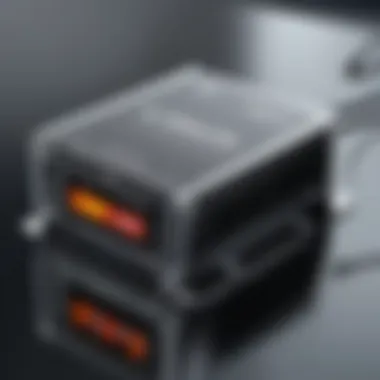

Installing a 110V to 12V DC converter is a pivotal step that requires careful planning and execution. This process not only ensures the device functions efficiently but also safeguards against potential hazards. A line can be drawn between a haphazard installation and a well-thought-out one where the latter promises longevity and reliability. When it comes to electronics, you definitely want to avoid the nightmare of malfunctioning devices or, worse, safety risks.
Preparing the Installation Site
Before diving in, assessing the installation site is essential. A clean and clutter-free environment can make a world of difference. Consider factors like ventilation and proximity to water sources. Ensure there’s enough space to work comfortably, preventing injuries or unexpected accidents.
Moreover, think about the surface where the converter will sit. A sturdy, flat surface is ideal. If mounting is involved, hardware that can adequately hold the converter in place is necessary. Inadequate support could lead to not just equipment failure but possibly an electrical fire.
Some tips to consider include:
- Keep tools organized and within reach.
- Ensure the site is dry and free of debris.
- Check local building codes that may affect your setup.
Getting the space ready isn’t just about clearing; it’s about positioning for success.
Wiring Guidelines
Once your site is prepped, it’s time to tackle wiring—arguably the heart of the process. Proper wiring ensures that power is routed correctly, preventing overloads and short circuits. You need to choose appropriate wire sizes and types based on the current your converter will handle. Misjudging this can lead to overheating, a risk that no one should take lightly.
Here are some key guidelines to follow:
- Use the Right Gauge: Thicker wires can carry more current without heating excessively.
- Secure Connections: All connections should be firm, avoiding any loose ends which could lead to arcing.
- Color Code Wires: Following standard color coding—black for negative, red for positive—helps in avoiding mix-ups.
It’s also wise to use insulated connectors and heat-shrink tubing, which can help shield connections from moisture and wear. You wouldn’t want something as simple as a loose wire to bring down your whole setup.
Testing the Setup
After the installation process, testing your setup is paramount. This phase confirms whether everything is working as intended before the converter becomes fully operational. A systematic approach ensures you catch any problems early on.
To conduct a thorough test:
- Visual Inspection: Before powering anything on, inspect all connections visually. Look for any signs of wear or improper connections.
- Initial Power On: Start with a lower voltage setting if your converter allows, monitoring for any unusual sounds or signs of distress.
- Use a Multimeter: Checking output voltage with a multimeter can help confirm that your converter is functioning correctly. Make sure it matches the expected 12V output.
"By taking the time to properly prepare, wire, and test, you set the stage for safe and effective device operation."
Overall, the installation and setup of a 110V to 12V DC converter is not just a simple task of plugging in and flipping switches. It’s an intricate process that demands attention to detail, and a proactive approach can save you time and potential headaches down the road.
Troubleshooting Common Problems
Understanding how to troubleshoot common problems in 110V to 12V DC converters is crucial for anyone using or planning to use these devices. With the rising demand for efficient power management in various applications, addressing issues is not just about maintenance; it's about ensuring that your devices perform reliably without compromising safety. This section emphasizes why mastering troubleshooting is a key asset, helping tech enthusiasts, gamers, DIY builders, and electronic upgraders to maintain their systems effectively.
Overheating Issues
Overheating can be a real headache when dealing with 110V to 12V converters. There are several reasons this might happen, and identifying them early is critical. Often, improper installation or insufficient ventilation contributes to excess heat buildup.
- Ventilation: Make sure there is ample airflow. If the unit is stuffed in a corner without space to breathe, you’re courting disaster. Not even a premium converter can cool itself under such conditions.
- Load Mismanagement: Running a converter at near or over its capacity can also lead it to run hot. This never bodes well for longevity, and components can warp or fail over time due to consistently high temperatures.
"Preventing overheating is easier than fixing a burned-out converter!"
Taking time to ensure your device is well above board with these considerations will save you a truckload of hassle.
Voltage Fluctuations
Voltage fluctuations can be like a yo-yo; when they happen, your devices feel the brunt of it. These fluctuations can stem from several factors, like sudden changes in load or issues with the power source itself.
- Input Voltage Stability: The first thing to check is the source voltage. If your home supply is shaky, that’s where the issue lies. Sometimes, it’s not the converter at all!
- Overloaded Circuits: Another culprit may be running too many devices at once on the same circuit. Spreading the load across multiple circuits often smoothens things out.
- Capacitor Quality: Quality counts. Low-grade capacitors can’t handle the stress when fluctuations hit, causing instability in output voltage.
Ensuring a steady input voltage and watching the overall load can mitigate many headaches associated with voltage fluctuations.
Component Failures
Component failures in 110V to 12V converters can put a damper on any project. These failures can arise from wear and tear, adverse environmental conditions, or simply choosing the wrong components in the first place.
- Inspect Connections: Loose connections might be the unseen enemy. Regular checks can save you from a domino effect where one failure leads to another.
- Identify Faulty Components: Some symptoms of failing components could be sparking, burning smells or a sudden increase in temperature. Address these signals promptly.
- Quality Control: Always choose high-quality, reputable brands while sourcing components. Cheap may sound appealing, but it can turn out to be costly when things go south.
Being vigilant about your components and maintaining best practices in installation and use can greatly decrease the chances of unexpected failures in your converter.
Safety Considerations
When dealing with 110V to 12V DC converters, safety isn’t just a good practice; it’s an absolute necessity. These devices can handle significant voltage changes and if mishandled, potential hazards can arise, impacting both the user and the device itself. Understanding safety considerations can help prevent accidents, injuries, or damage to both equipment and people.
Electrical Safety Standards
In most places, electrical safety standards act as guidelines to ensure that devices operate safely within certain parameters. These standards are like the rules of the road for electrical devices, guiding manufacturers and users alike on how to properly use equipment. Key standards to be aware of include the National Electrical Code (NEC) in the United States and the International Electrotechnical Commission (IEC) standards used globally.
Operating a 110V to 12V converter must conform to these standards. For instance, these devices need to be properly grounded to prevent electric shocks. Moreover, when setting up your converter, ensuring it is in well-ventilated space is crucial. This helps to dissipate heat, reducing the risk of fire hazards.
Here are some essential points to keep in mind regarding electrical safety standards:
- Read the User Manual: The guidance provided by the manufacturer is invaluable in ensuring safety.
- Check for Compliance Marks: Look for certifying marks (like UL or CE) that indicate adherence to safety standards.
- Use Proper Circuit Breakers: Ensure the setup includes appropriate circuit breakers to prevent overload conditions.
"Safety is not just a priority; it’s a fundamental requirement when working with electrical devices. Always know the rules of the game."
Personal Protective Equipment
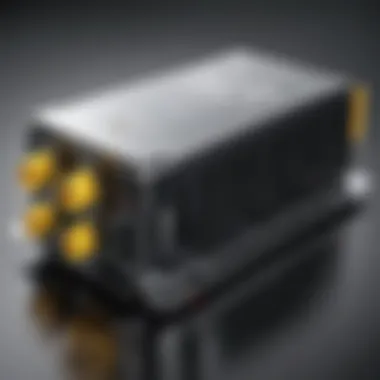

While electrical standards set the stage for safety, personal protective equipment (PPE) serves as an individual's first line of defense against potential hazards. It’s like wearing a helmet when riding a bike—an essential precaution that can make a world of difference.
When working with 110V to 12V DC converters, you might want to consider the following PPE:
- Insulated Gloves: They prevent current from passing through your hands, protecting you from shocks.
- Safety Glasses: Protect your eyes from debris or electrical splashes during the setup.
- Non-slip Shoes: If you happen to be in a wet or cluttered environment, good footwear can prevent accidental slips.
These items may seem basic, but they play a crucial role in minimizing risks. It isn’t always necessary to gear up like you’re about to climb Everest, but taking small precautions can mean the difference between a safe experience and a dangerous encounter.
Regulatory and Compliance Issues
Understanding regulatory and compliance issues is an essential aspect of working with 110V to 12V DC converters. These elements not only ensure the safe and efficient operation of electrical devices but also protect consumers and manufacturers alike from legal repercussions and safety hazards.
In many regions, specific codes dictate how electrical devices are built and installed. These standards aim to minimize risks such as electrical fires, electrocution, or equipment failure. Compliance with local electrical codes is, therefore, not just advisable; it’s a legal requirement. Many professionals in the field consider this a top concern when designing or installing systems that utilize these converters. Compliance doesn't imply merely meeting the minimum requirements but also ensuring the longevity and reliability of the devices.
Moreover, abiding by these regulations can be a strong selling point for products in a competitive market. Consumers are more likely to trust products backed by verified compliance since it speaks volumes about quality and safety.
Local Electrical Codes
Local electrical codes vary from region to region, reflecting not just safety regulations but also regional practices and technologies. For instance, what works in sub-tropical areas might not be adequate in colder climates where additional insulation may be required.
Getting familiar with these codes is crucial for anyone dealing with 110V to 12V DC converters. Here are a few factors to consider when navigating these regulations:
- Understanding Reference Standards: Many local codes are based on widely recognized standards such as the National Electrical Code (NEC) in the United States. This code provides guidelines focusing on safety and electrical practices.
- Installation Considerations: Local codes may specify how wiring, panel placements, and ground fault protections must be implemented. Adherence isn’t optional; deviations can lead to penalties or worse outcomes.
- Permitting Requirements: Some installations require permits. Not securing the necessary insignia can complicate sales down the line if ever an inspection is performed.
When contemplating an electrical project, it’s often a good call to consult a local electrical inspector or a qualified electrician to ensure compliance with these codes.
Import/Export Regulations
Navigating import/export regulations is a critical aspect for businesses dealing with 110V to 12V DC converters, especially those seeking international markets. Several key considerations come into play:
- Adherence to International Standards: Some countries require electrical components to meet specific international standards such as IEC (International Electrotechnical Commission) guidelines. These regulations ensure that products are deemed safe and environmentally friendly.
- Documentation: Importers must often present a slew of documents, including conformity certifications, to customs authorities. Failure to comply can result in fines or the seizure of goods.
- Market Specifics: Some regions may have unique restrictions on certain materials used in electrical products. For example, rosin core solder might be disallowed due to environmental concerns.
Each country has its own set of rules; understanding them can save time, money, and headaches down the road.
By ensuring compliance with both local codes and international regulations, you not only safeguard yourself against potential legal issues but also pave the way for smoother operations in the marketplace. Understanding these parameters is an investment in the future reliability and safety of your electrical systems.
Comparative Analysis of Popular Models
A comparative analysis of popular models serves as a crucial piece within this article. As tech enthusiasts, gamers, DIY builders, and electronic upgraders navigate through the choices of 110V to 12V DC converters, understanding differences between specific models can save time and ensure they select the right device for their needs. Such an analysis allows users to consider both performance and budget, as the landscape of converters can appear vast and overwhelming. With the right information, decision-making becomes a lot easier, helping one to focus on what truly matters.
Budget Options
When it comes to budget options, several models stand out without compromising too much on performance. Budget converters typically range from inexpensive to moderately priced, making them appealing for a variety of users. For instance, a budget model like the KISAE 300-Watt Power Inverter is often celebrated for its simplicity and effectiveness in converting voltage without putting a dent in your wallet. Users appreciate the straightforward plug-and-play functionality, which eliminates the need for advanced technical expertise. This model, along with others like it, generally excels in applications where high efficiency is not the priority, such as powering small electronics or lighting. However, it's essential to keep in mind that while these converters might suit light use, they may struggle under heavy loads, leading to potential overheating and inefficiencies.
Mid-Range Converters
Progressing to mid-range converters, the options become more diverse, offering better efficiency and reliability. One notable model in this category is the Samlex America SEC-1212. This converter illustrates how mid-range products merge power and performance without breaking the bank. Users often find these converters equipped with additional features such as built-in protection against overvoltage and short circuits. Such enhancements contribute to the longevity of the device and the safety of connected electronics. With a reliable output current and efficiency ratings hovering around 90% and above, these converters are well-suited for medium-sized application scenarios, like powering multiple devices simultaneously. The additional price paid compared to budget options often translates to peace of mind and enhanced durability.
High-End Choices
Finally, let's turn our attention to high-end choices. These models generally command a higher price tag but bring along significant benefits that justify the cost. One prominent player is the Victron Energy Phoenix Inverter. Its robust design and uncompromising efficiency make it a favorite among serious hobbyists and professionals alike. Typically, high-end converters offer a range of options for customization and advanced features. For instance, they may include Wi-Fi connectivity for remote monitoring and control. These features can easily make a difference in critical situations, like when managing a solar power setup or a complicated off-grid installation. Furthermore, the thermal management in high-end models tends to handle extended use much better, preventing overheating and increasing unit lifespan. Thus, choosing a high-end option often becomes an investment in both performance and reliability.
"Selecting the right model for your needs can be the difference between a smooth sailing experience and a shocking turn of events."
By weighing budget, mid-range, and high-end options against personal requirements and financial constraints, users position themselves to make informed decisions within the realm of 110V to 12V DC converters. This comparative analysis not only streamlines the selection process but also aligns with the ultimate goal: to ensure optimal performance and satisfaction.
Future Trends in Voltage Conversion
The landscape of voltage conversion technologies is evolving rapidly, driven by advances in electronic and renewable energy systems. Understanding these trends is crucial for users looking to optimize their setups, be it for home, automotive, or industrial applications. The innovations cannot only enhance efficiency but also pave the way for more sustainable energy practices.
Innovations in Converter Technology
Recent advancements in converter technology are nothing short of exciting. For one, the emergence of more compact, lightweight designs is reshaping how we think about power supply units. With integrated circuit designs becoming smaller and more efficient, devices that once required bulky converters can now run on sleek, modern designs. Not to mention, these new designs often boast increased reliability and lower failure rates.
Moreover, the introduction of digital controls in converters has allowed for smarter operational capabilities. For example, converters can now adjust their outputs based on real-time data, increasing efficiency and reducing waste. This responsiveness not only enhances performance but also ensures that devices get the right amount of power when they need it.
"In the world of voltage conversion, staying ahead means adopting the latest technological advancements to maximize efficiency and performance."
Adaptive filtering techniques in these converters have also piqued interest. Rather than being static in their function, these systems adapt and filter noise, ensuring that voltage output remains steady, even when input conditions fluctuate. The result? Cleaner power supply that prolongs the life of sensitive electronic components.
Impacts of Renewable Energy Adoption
As the world shifts towards greener energy, the integration of renewable sources like solar and wind into our power infrastructure is revolutionizing voltage conversion technology. Renewable energy systems often output varying voltages depending on conditions, presenting a unique challenge for efficiency and stability.
This is where advanced DC-DC converters come into play. They facilitate the conversion of inconsistent renewable sources to a stable 12V required for many devices. As households increasingly adopt solar panels or wind turbines, the need for effective voltage conversion systems is paramount.
With the rising use of battery storage systems, ensuring compatibility with these renewable sources is also coming to the forefront. New converter technologies are geared towards synchronizing battery charging while allowing users to draw power efficiently when needed.
In addition, there’s a growing trend towards energy management systems, which coordinate multiple sources to optimize usage. These systems are particularly beneficial in large-scale renewable setups, such as solar farms, where efficient management of various voltages ensures that energy is harnessed effectively.
In summary, the trends in voltage conversion point toward a future that is not only more efficient but also more adaptable to the fast-paced changes in technology and energy production. Keeping an eye on these developments will empower tech enthusiasts, gamers, DIY builders, and electronic upgraders to make informed decisions and stay ahead in their projects.
The End
In wrapping up this guide, it's clear that understanding the nuances of 110V to 12V DC converters is more than just a technical exercise—it's a vital cog in the machinery of modern electronics. As our reliance on various power-operated devices increases, so does the necessity to efficiently convert voltage levels for optimal performance. This article has laid out the essential facets of these converters, from their basic functions to their applications in everyday life.
Summary of Key Points
The key points surrounding 110V to 12V converters resonate with many aspects of electrical engineering:
- Functionality: These converters play a pivotal role in changing voltage, enabling devices designed for lower voltages to operate safely and effectively.
- Types of Converters: We broke down the different types of converters—linear, switching, buck, and boost—each offering distinct advantages depending on the intended use.
- Technical Specs: Important specifications like output current ratings and efficiency ratings can greatly influence performance; knowing these can help in making informed purchasing decisions.
- Applications: The varied applications, from home electronics to renewable energy, show how integral these converters are across multiple sectors.
- Safety & Compliance: Adhering to safety standards and understanding regulatory issues ensures that users not only protect their devices but also adhere to local laws and standards.



